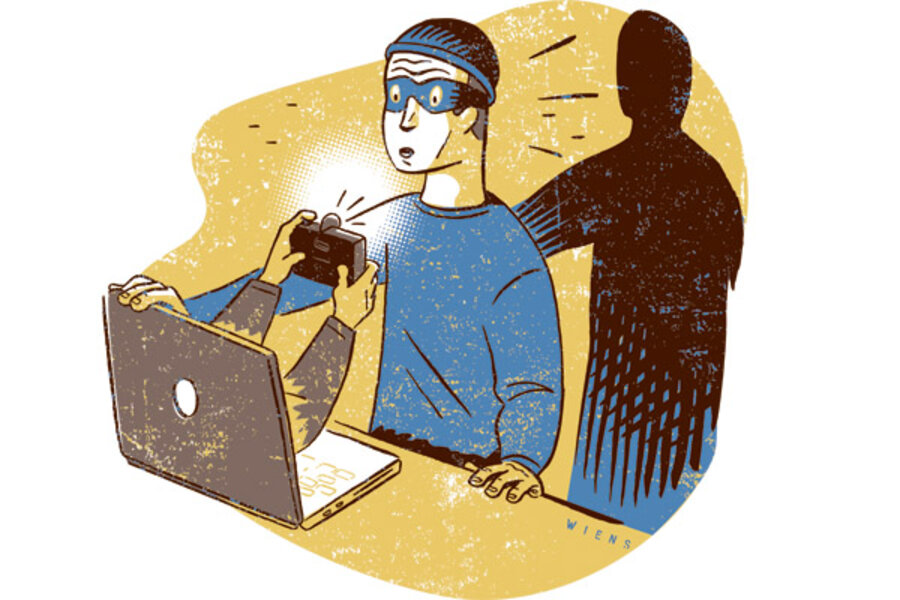How to track down a stolen gadget
Loading...
Theft is a tough crime to crack. Burglars rarely leave behind any evidence; witnesses are few and far between; and police resources, especially in cities, often go toward homicides and other more pressing crimes.
In Oakland, Calif., three police investigators must juggle 2,400 new reports of stolen property each month.
"Laptops are not so much a priority," says Holly Joshi, spokeswoman for the Oakland Police Department. "Unless a citizen has seen the burglar, we don't have the staffing levels to chase everything down."
So when Joshua Kaufman reported the theft of his MacBook to the Oakland police in March, he didn't hear anything back. But Mr. Kaufman had a secret weapon. Before his computer was stolen, he had installed Hidden, a laptop locator.
Hidden, and other forms of software like it, offer gadget owners some peace of mind. The programs help track down and recover lost or stolen electronics. Here are some of the best options for Macs, PCs, phones, and digital cameras:
Computers: The Hidden software runs quietly in the background, providing three useful, if borderline creepy, tools to locate iMacs and MacBooks. For $15 a year, the program can pinpoint a missing machine to within a quarter-mile radius, allow a Mac's true owner to take screen shots of what programs are running, and remotely turn on the laptop's webcam to snap pictures of the person using it.
A month after the break-in, Kaufman handed police a trove of images and information about his MacBook's illegitimate new owner. Since burglars often fence stolen property, Kaufman couldn't be sure if the young man in these pictures was the actual robber, but he provided police with the person's work e-mail account, tying the suspect to a local taxi company.
After some extra nudging from news outlets and social media, including Kaufman's own blog (called This Guy Has My MacBook), the police arrested the man on May 31 and reunited Kaufman with his missing laptop.
Prey performs many of the same features for Macs, PCs, and Linux computers – without the annual fee. If your laptop goes missing, Prey will continuously search for an Internet connection. Once it can phone home, the software will e-mail its owner with approximate coordinates.
Unfortunately, Prey and Hidden only work if the computer is turned on, and a smart crook could wipe your hard drive, removing the software. Still, applications such as Hidden and Prey are "definitely a helpful tool," says Ms. Joshi, with the Oakland police. "It's not very expensive, so if people feel comfortable doing so, they should look into installing it."
Go to hiddenapp.com and preyproject.com for details and downloads.
Phones: Between satellite data, Wi-Fi triangulation, and cell-tower signals, mobile phones are one of the easiest devices to track down – if you have the right software.
Apple has a free Find My iPhone feature. The service, part of Apple's MobileMe, will pinpoint a lost or stolen iPhone, iPad, or iPod Touch to within a few yards. The owner can send an alert that will pop up on the device's screen, such as a message that reads, "If found, please contact …" Apple can also remotely add password protection or erase the hard drive entirely.
Android phone users can download Lookout, a free app that locates lost phones, as well as back up contacts and install anti-malware protection. The company also has a $30-a-year premium service that lets you lock down or remotely wipe an Android device.
In March, a beta version of BlackBerry Protect opened up free tools to locate and erase handsets. Many of these features already came included in BlackBerry's enterprise packages.
Cameras: Most digital photographs come with detailed information hidden inside the code. These secret tags note the shutter speed, flash settings – and the serial number of the camera.
GadgetTrak.com/CameraSearch scours the Internet for images and logs every serial number it can find.
The new website has filed 3.5 million unique identifiers in less than a month. Enter your serial number and the free service will sniff out photos taken from that camera.
If GadgetTrak brings up images you don't recognize, it may have just ratted out a sneaky child who's borrowed your camera without asking – or identified the thief who's made off with your stolen dSLR.
Increasingly, modern cameras also record where an image was taken, providing extra evidence against a culprit.
GadgetTrak's Camera Search and similar site StolenCameraFinder.com are rather new services. They may not have indexed your photos yet. If a serial-number search comes up dry, try again in a few weeks or months.
[Editor's Note: The original version of this story called Stolen Camera Finder a "competitor" to Camera Search. In fact, GadgetTrak shares its data, loading what it finds into the SCF database.]





